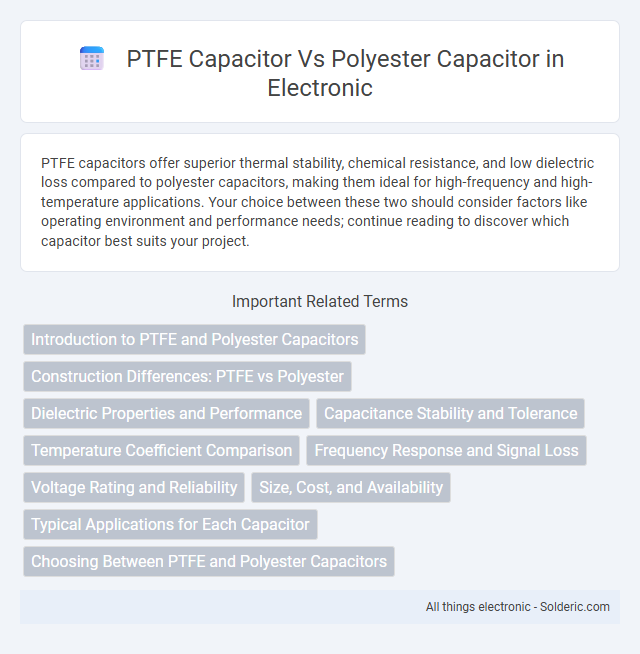PTFE capacitors offer superior thermal stability, chemical resistance, and low dielectric loss compared to polyester capacitors, making them ideal for high-frequency and high-temperature applications. Your choice between these two should consider factors like operating environment and performance needs; continue reading to discover which capacitor best suits your project.
Comparison Table
| Feature | PTFE Capacitor | Polyester Capacitor |
|---|---|---|
| Dielectric Material | Polytetrafluoroethylene (PTFE) | Polyester (PET) |
| Temperature Range | -55degC to 200degC | -55degC to 125degC |
| Dielectric Loss | Very low (tan d 0.0002) | Moderate (tan d 0.02) |
| Capacitance Stability | High stability over temperature and frequency | Good but less stable than PTFE |
| Insulation Resistance | Very high | High |
| Applications | High-frequency circuits, RF applications, precision electronics | General-purpose, consumer electronics, low-frequency applications |
| Cost | Higher | Lower |
| Size | Typically larger for given capacitance | Smaller for given capacitance |
| Moisture Resistance | Excellent | Moderate |
Introduction to PTFE and Polyester Capacitors
PTFE capacitors, known for their exceptional thermal stability and low dielectric loss, utilize polytetrafluoroethylene as the dielectric material, making them ideal for high-frequency and high-temperature applications. Polyester capacitors, using polyethylene terephthalate as the dielectric, offer a cost-effective solution with good electrical properties suitable for general-purpose electronic circuits. Both capacitor types serve distinct roles based on their dielectric properties, operating temperature ranges, and frequency response, impacting performance in precision and power electronics.
Construction Differences: PTFE vs Polyester
PTFE capacitors utilize polytetrafluoroethylene as the dielectric material, offering superior thermal stability and chemical resistance compared to polyester capacitors, which use polyethylene terephthalate film. The PTFE film in these capacitors provides lower dielectric losses and higher voltage ratings, making them ideal for high-frequency and high-temperature applications. Your choice between PTFE and polyester capacitors hinges on the specific performance requirements, with PTFE capacitors excelling in demanding environments due to their robust construction.
Dielectric Properties and Performance
PTFE capacitors exhibit superior dielectric properties with an exceptionally low dissipation factor and high dielectric strength, making them ideal for high-frequency and high-temperature applications. Polyester capacitors offer moderate dielectric constants and higher dielectric losses, which limit their performance in precision or high-frequency circuits. The PTFE dielectric provides excellent chemical stability and minimal moisture absorption, resulting in enhanced long-term reliability compared to polyester capacitors.
Capacitance Stability and Tolerance
PTFE capacitors exhibit exceptional capacitance stability with minimal drift over wide temperature ranges and frequencies, maintaining tight tolerances often within +-1%. Polyester capacitors display moderate capacitance stability but can experience greater variation due to temperature changes and aging, with typical tolerances around +-5% to +-10%. The inherent dielectric properties of PTFE enable superior performance in high-precision applications requiring consistent capacitance values.
Temperature Coefficient Comparison
PTFE capacitors exhibit a significantly lower temperature coefficient, typically around +-5 ppm/degC, compared to polyester capacitors, which range between +-100 to +-250 ppm/degC, ensuring greater stability in varying temperature environments. Your electronic designs benefit from PTFE's superior thermal performance when precision and minimal capacitance variation are critical. Choosing PTFE capacitors reduces drift in circuits exposed to wide temperature fluctuations, enhancing overall reliability.
Frequency Response and Signal Loss
PTFE capacitors exhibit superior frequency response due to their extremely low dielectric constant and dissipation factor, making them ideal for high-frequency applications. In contrast, polyester capacitors have higher signal loss and limited performance at elevated frequencies because of their greater dielectric absorption. For your circuits requiring minimal signal distortion and enhanced high-frequency stability, PTFE capacitors provide a more reliable solution.
Voltage Rating and Reliability
PTFE capacitors offer superior voltage ratings, often exceeding 500V, making them ideal for high-voltage applications, while polyester capacitors typically handle voltages up to 250V. The stability of PTFE capacitors under extreme temperatures and their low dielectric losses contribute to greater long-term reliability compared to polyester types. When selecting a capacitor for critical circuits, your choice influences performance, with PTFE capacitors providing enhanced durability and consistent operation in demanding environments.
Size, Cost, and Availability
PTFE capacitors typically offer superior stability and high-temperature performance but are larger in size and significantly more expensive than polyester capacitors, which are compact and cost-effective for general applications. Polyester capacitors are widely available in various standard sizes and capacitance values, making them a common choice for consumer electronics. The specialized manufacturing process of PTFE capacitors limits their availability compared to the mass-produced polyester types.
Typical Applications for Each Capacitor
PTFE capacitors excel in high-frequency and high-temperature applications, making them ideal for RF circuits, aerospace, and military electronics where stability and low dielectric loss are critical. Polyester capacitors are commonly used in general-purpose applications such as audio circuits, power supply filtering, and timing circuits due to their cost-effectiveness and good electrical characteristics. The selection depends on the operating environment, with PTFE suited for demanding conditions and polyester preferred for consumer electronics requiring moderate performance.
Choosing Between PTFE and Polyester Capacitors
PTFE capacitors offer superior dielectric strength, low dissipation factor, and excellent thermal stability, making them ideal for high-frequency and high-temperature applications. Polyester capacitors, while more cost-effective, provide good electrical performance but with higher dielectric losses and less stability under thermal stress. Selecting between PTFE and polyester capacitors depends on application requirements such as frequency range, operating temperature, and budget constraints.
PTFE capacitor vs polyester capacitor Infographic

 solderic.com
solderic.com